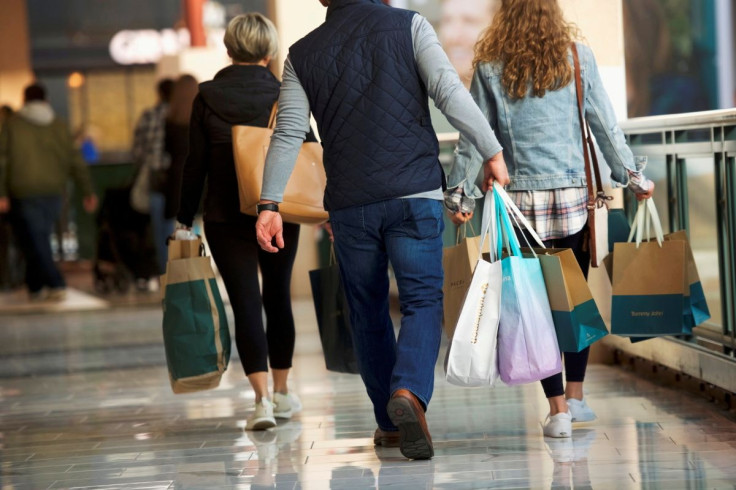U.S. Retail Sales Slow, Huge Savings Likely To Provide A Cushion Against Inflation

U.S. retail sales increased moderately in February as more expensive gasoline and food forced households to cut back spending on other goods like furniture, electronics and appliances, which could restrain economic growth this quarter.
The report from the Commerce Department on Wednesday, however, showed the rebound in sales in January was much stronger than initially estimated. Record gasoline and high food prices are hitting lower-income households the hardest.
Overall, consumers are being cushioned by at least $2.5 trillion in excess savings accumulated during the COVID-19 pandemic. Worker shortages with a near-record 11.3 million job openings at the end of January are boosting wages and allowing some Americans to pick up extra shifts to augment their income.
"Though cooling after January's splurge, American consumers appear reasonably well positioned to keep spending, supported by recent massive job gains and high household savings," said Sal Guatieri, a senior economist at BMO Capital Markets in Toronto.
"This assumes, of course, no further major blows to fuel and food costs, confidence, and financial conditions stemming from the Russia-Ukraine war."
Retail sales increased 0.3% last month. Data for January was revised sharply higher to show sales surging 4.9% instead of 3.8% as previously reported. Economists polled by Reuters had forecast retail sales growth slowing to 0.4%, with estimates ranging from as low as a 0.7% fall to as high as a 1.7% rise.
Retail sales increased 17.6% from a year ago. Economists also viewed the pull back in monthly sales last month as pay back after January's surge, which was the largest gain in 10 months. Others saw the moderation as the beginning of a shift in spending back to services from goods amid a significant decline in coronavirus infections.
The Federal Reserve on Wednesday raised its policy interest rate by 25 basis points, the first hike in more than three years, to quell inflation. The U.S. central bank laid out an aggressive plan to push borrowing costs to restrictive levels by next year. Fed said Russia's war against Ukraine was "likely to create additional upward pressure on inflation and weigh on economic activity."
Retail sales are mostly made up of goods and are not adjusted for inflation. Last month, sales at auto dealerships increased 0.8%. The rise likely reflected higher prices amid shortages, as motor vehicle manufacturers reported a decline in unit sales in February. Auto sales accelerated 6.9% in January.
Receipts at service stations shot up 5.3%. Gasoline prices jumped 24 cents to an average of $3.49 per gallon last month from January, according to data from the U.S. Energy Information Administration. They have since pushed to a record high above $4 per gallon after Russia's invasion of Ukraine on Feb. 24.
The three-week war, which has killed hundreds of civilians, has boosted wheat prices and is expected to put more pressure on strained global supply chains.
Annual consumer prices increased by the most in 40 years in February. Inflation is likely to remain uncomfortably high, with a separate report from the Labor Department on Wednesday showing import prices increasing 1.4% in February, lifted by higher costs for petroleum products and food.
Stocks on Wall street were trading higher amid signs of progress in Ukraine-Russia peace talks. The dollar slipped against a basket of currencies. U.S. Treasury yields rose.
UNDERLYING STRENGTH
Retail sales in February were held back by a 3.7% plunge in receipts at online retailers. Sales at furniture stores fell 1.0%. Consumers also cut back on spending at health and personal care stores, with sales declining 1.8%. Receipts at electronic and appliance stores dropped 0.6%.
But consumers spent more on clothing as well as sporting goods, hobbies, musical instruments and books. Receipts at restaurants and bars rebounded 2.5%. Restaurants and bars are the only services category in the retail sales report.
Excluding automobiles, gasoline, building materials and food services, retail sales fell 1.2% in February. Data for January was revised substantially up to show these so-called core retail sales rebounding 6.7% instead of 4.8% as previously reported.
Core retail sales correspond most closely with the consumer spending component of gross domestic product. The upward revision to January core retail sales offset the decline in February, which could leave consumer spending on a fairly strong growth path in the first quarter.
Indeed, economists at Morgan Stanley raised their consumer spending growth estimate to a 4.3% annualized rate from a 2.7% pace. That lifted their GDP growth forecast for the first quarter to a 3.7% rate from a 2.5% pace.
Morgan Stanley's GDP growth estimates are on the upper end of the range, with some forecasts below a 1% pace. The economy grew at a robust 7.0% rate in the fourth quarter.
"Today's report continues to reflect strong consumer demand in the first quarter, despite the headwinds of elevated inflation," said Ellen Zentner, chief U.S. economist at Morgan Stanley in New York. "Upside in food services spending also indicates that we should see more upside in services spending this month, which will be reflecting in the personal spending report in two weeks."
© Copyright Thomson Reuters 2024. All rights reserved.




















